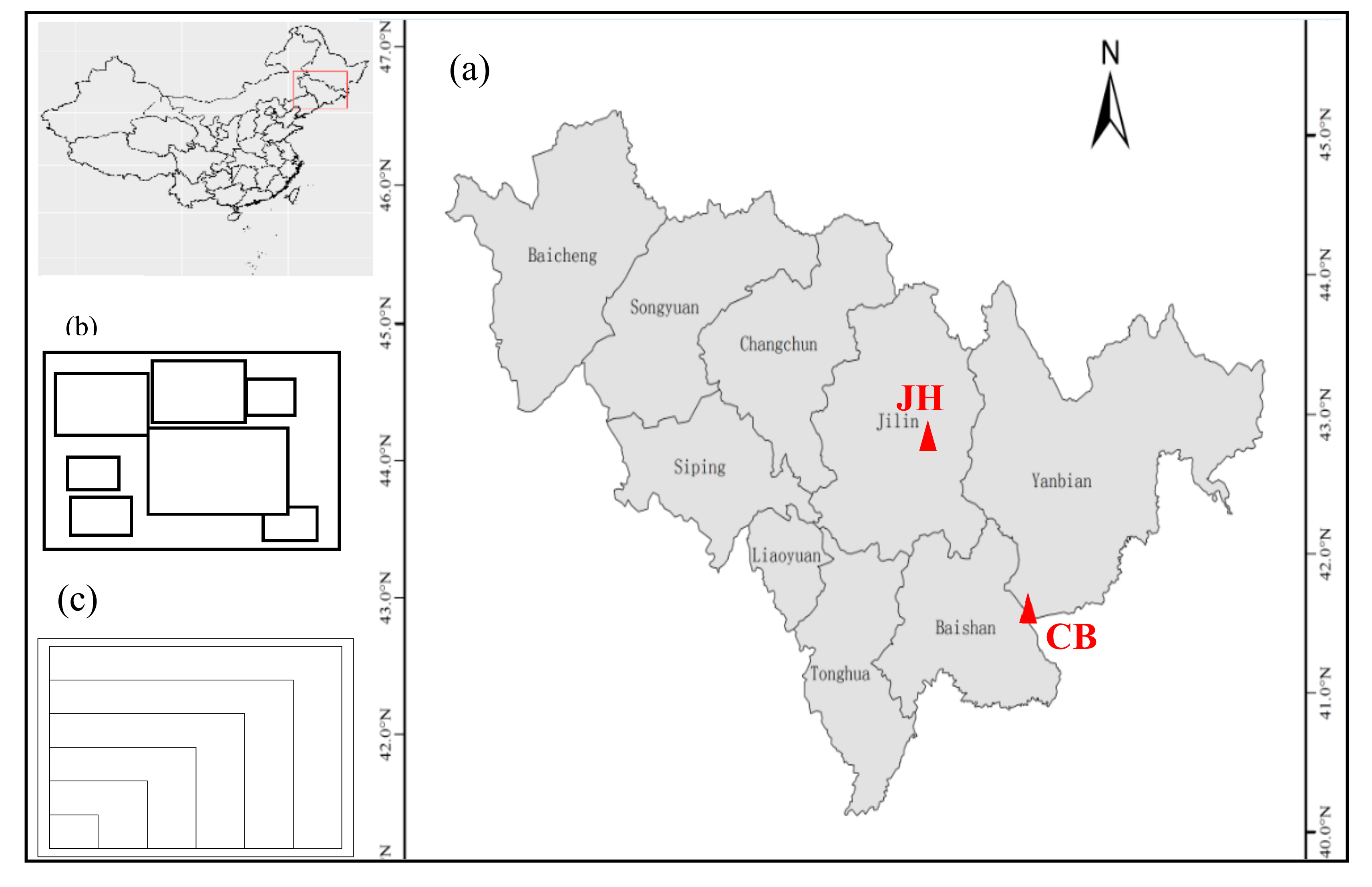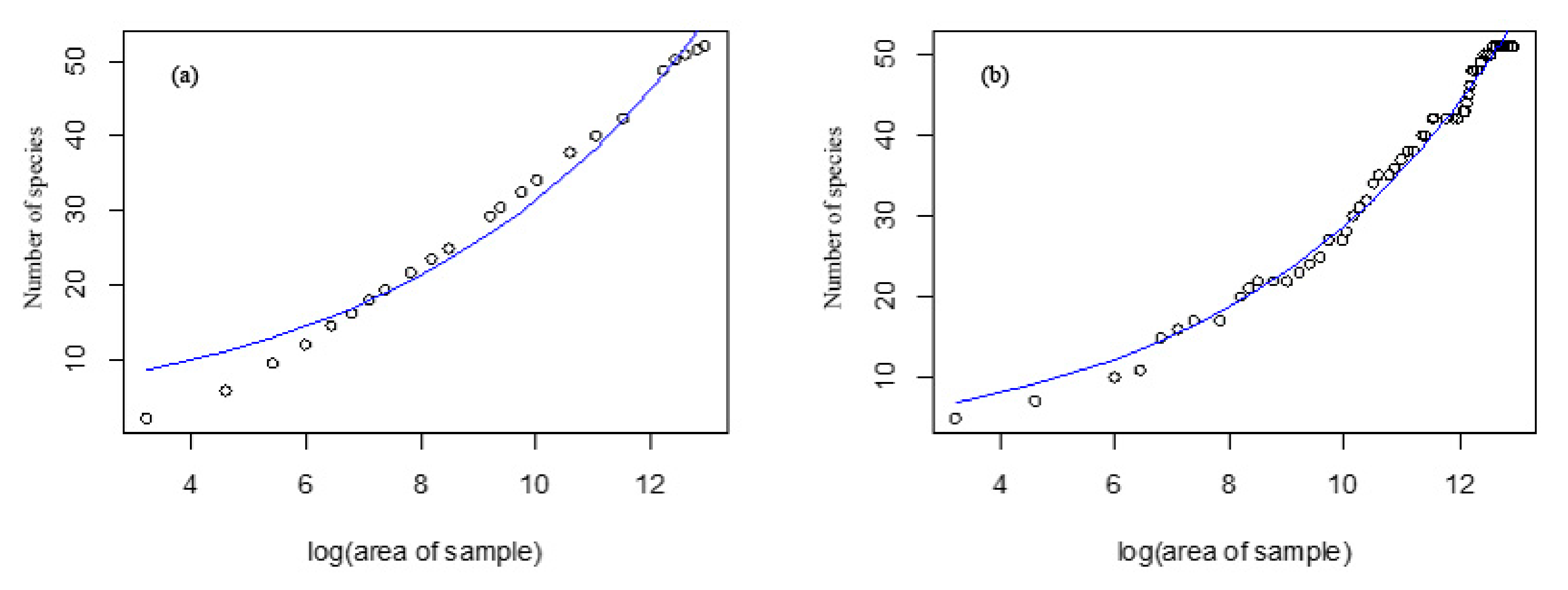Species-Area Relationship and Its Scale-Dependent Effects in Natural Forests of North Eastern China
Abstract
1. Introduction
2. Materials and Methods
2.1. Study Sites
2.2. Sampling Plot Setting and Data Survey
2.3. Sampling Methods
2.4. The Evaluation of the Goodness-of-Fit of Species-Area Models
3. Results
3.1. The Composition of Species and Structural Characteristics of Dominant Populations
3.2. The Species-Area Relationship Obtained by Nested Sampling
3.3. The Species-Area Relationship Obtained by Random Sampling
3.4. The Species-Area Relationship at Different Scales
4. Discussion
4.1. The Optimal Species-Area Model
4.2. Scale Dependence of the Species-Area Relationship
4.3. The Effect of Habitat Heterogeneity on Species-Area Relationship
5. Conclusions
Author Contributions
Funding
Acknowledgments
Conflicts of Interest
References
- Lomolino, M.V. The species-area relationship: new challenges for an old pattern. Prog. Phys. Geog. 2001, 25, 1–21. [Google Scholar]
- Zurlini, G.; Rossi, G.O. Spatial-accumulation pattern and extinction rates of mediterranean flora as related to species confinement to habitats in preserves and larger areas. Conserv. Biol. 2002, 16, 948–963. [Google Scholar] [CrossRef]
- Ricklefs, R.; Bermingham, E. History and the species-area relationship in lesser antillean birds. Am. Nat. 2004, 163, 227–239. [Google Scholar] [CrossRef][Green Version]
- Bramson, M.; Cox, J.T.; Durrett, R. Spatial models for species area curves. Ann. Probab. 1996, 24, 1727–1751. [Google Scholar] [CrossRef]
- Losos, J.B.; Schluter, D. Analysis of an evolutionary species-area relationship. Nature 2000, 408, 847–850. [Google Scholar] [CrossRef] [PubMed]
- Pimm, S.L.; Raven, P. Biodiversity-Extinction by numbers. Nature 2000, 403, 843–845. [Google Scholar] [CrossRef] [PubMed]
- Malcolm, J.R.; Liu, C.; Neilson, R.P.; Hansen, L.; Hannah, L. Global warming and extinctions of endemic species from biodiversity hotspots. Conserv. Biol. 2010, 20, 538–548. [Google Scholar] [CrossRef]
- Simberloff, D.S.; Abele, L.G. Island biogeography theory and conservation practice. Science 1976, 191, 285–286. [Google Scholar] [CrossRef] [PubMed]
- Fridley, J.D.; Peet, R.K.; Wentworth, T.R.; White, P.S. Connecting fine- and broad-scale species-area relationships of southeastern U.S. flora. Ecology 2005, 86, 1172–1177. [Google Scholar] [CrossRef]
- Palmer, M.W.; White, P.S. Scale dependence and the species-area relationship. Am. Nat. 1994, 144, 717–740. [Google Scholar] [CrossRef]
- Powell, K.I.; Chase, J.M.; Knight, T.M. Invasive plants have scale-dependent effects on diversity by altering species-area relationships. Science 2013, 339, 316–318. [Google Scholar] [CrossRef] [PubMed]
- Arrhenius, O. Species and Area. J. Ecol. 1921, 9, 95–99. [Google Scholar] [CrossRef]
- Pastor, J.; Downing, A.; Erickson, H.E. Species-area curves and diversity-productivity relationships in beaver meadows of voyageurs national park, Minnesota, USA. Oikos 1996, 77, 399–406. [Google Scholar] [CrossRef]
- Gleason, H.A. On the relation between species and area. Ecology 1922, 3, 158–162. [Google Scholar] [CrossRef]
- Turner, W.R.; Tjørve, E.; Hillebrand, H. Scale-dependence in species-area relationships. Ecography 2005, 28, 721–730. [Google Scholar] [CrossRef]
- Storch, D.; Keil, P.; Jetz, W. Universal species-area and endemics-area relationships at continental scales. Nature 2012, 488, 78–81. [Google Scholar] [CrossRef]
- He, F.L.; Legendre, P. On species-area relations. Am. Nat. 1996, 148, 719–737. [Google Scholar] [CrossRef]
- Connor, E.F.; Mccoy, E.D. The statistics and biology of the species-area relationship. Am. Nat. 1979, 113, 791–833. [Google Scholar] [CrossRef]
- Tjørve, E. Shapes and functions of species-area curves: A review of possible models. J. Biogeogr. 2003, 30, 827–835. [Google Scholar] [CrossRef]
- Kilburn, P.D. Exponential values for the species-area relation. Science 1963, 141, 1276. [Google Scholar] [CrossRef]
- Simone, F. Detecting biodiversity hotspots by species-area relationships: A case study of mediterranean beetles. Conserv. Biol. 2010, 20, 1169–1180. [Google Scholar]
- Harte, J.; Smith, A.B.; Storch, D. Biodiversity scales from plots to biomes with a universal species-area curve. Ecol. Lett. 2009, 12, 789–797. [Google Scholar] [CrossRef] [PubMed]
- Fisher, R.A. The relation between the number of species and the number of individuals in a random sample of an animal population. J. Anim. Ecol. 1943, 12, 42–58. [Google Scholar] [CrossRef]
- Scheiner, S.M. Six types of species-area curves. Global Ecol. Biogeogr. 2003, 12, 441–447. [Google Scholar] [CrossRef]
- Li, T.T.; Wu, J.; Chen, H.; Ji, L.Z.; Yu, D.P.; Zhou, L.; Zhou, W.M.; Tong, Y.W.; Li, Y.H.; Dai, L.M. Intraspecific functional trait variability across different spatial scales: A case study of two dominant trees in Korean pine broadleaved forest. Plant Ecol. 2018, 219, 1–12. [Google Scholar] [CrossRef]
- Zhang, C.; Zhao, X.; Gadow, K.V. Analyzing selective harvest events in three large forest observational studies in North Eastern China. For. Ecol. Manag. 2014, 316, 100–109. [Google Scholar] [CrossRef]
- Fan, C.; Tan, L.; Zhang, C.; Zhao, X.; von Gadow, K. Analysing taxonomic structures and local ecological processes in temperate forests in North Eastern China. BMC Ecol. 2017, 17, 33. [Google Scholar] [CrossRef]
- Archibald, E.E.A. The specific character of plant communities: II. A quantitative approach. J. Ecol. 1949, 37, 274–288. [Google Scholar] [CrossRef]
- Brillinger, D.R. Quasi-likelihood functions, generalized linear models, and the Gauss—Newton method. Biometrika 1974, 61, 439–447. [Google Scholar]
- Anderson, D.R.; Burnham, K.P.; White, G.C. AIC model selection in overdispersed capture-recapture data. Ecology 1994, 75, 1780–1793. [Google Scholar] [CrossRef]
- Wu, Z.Y.; Zhou, Z.K.; Li, D.Z.; Peng, H.; Sun, H. The areal-types of the world families of seed plants. Acta Bot. Yunnanica 2003, 25, 245–257. (In Chinese) [Google Scholar]
- Fattorini, S. To fit or not to fit? A poorly fitting procedure produces inconsistent results when the species-area relationship is used to locate hotspots. Biodivers. Conserv. 2007, 16, 2531–2538. [Google Scholar] [CrossRef]
- Inouye, R.S. Species-area curves and estimates of total species richness in an old-field chronosequence. Plant Ecol. 1998, 137, 31–40. [Google Scholar] [CrossRef]
- Gleason, H.A. Species and area. Ecology 1925, 6, 66–74. [Google Scholar] [CrossRef]
- Ulrich, W.; Buszko, J. Sampling design and the shape of species-area curves on the regional scale. Acta Oecol. 2007, 31, 54–59. [Google Scholar] [CrossRef]
- White, A.P.; Ethan, P. Effects of range size on species-area relationships. Evol. Ecol. Res. 2003, 5, 493–499. [Google Scholar]
- Legendre, H.P. Species diversity patterns derived from species-area models. Ecology 2002, 83, 1185–1198. [Google Scholar]
- Coleman, B.D. On random placement and species-area relations. Math. Biosci. 1981, 54, 191–215. [Google Scholar] [CrossRef]
- Jousset, A.; Bienhold, C.; Chatzinotas, A.; Gallien, L.; Gobet, A.; Kurm, V.; Küsel, K.; Rillig, M.C.; Rivett, D.W.; Salles, J.F.; et al. Where less may bemore: how the rare biosphere pulls ecosystems strings. ISME J. 2017, 11, 853–862. [Google Scholar] [CrossRef]
- Martín, H.G.; Goldenfeld, N. On the origin and robustness of power-law species-area relationships in ecology. Proc. Natl. Acad. Sci. USA 2006, 103, 10310–10315. [Google Scholar] [CrossRef]
- Kerr, J.T.; Packer, L. Habitat heterogeneity as a determinant of mammal species richness in high-energy regions. Nature 1997, 385, 252–254. [Google Scholar] [CrossRef]
- Axelsen, J.B.; Roll, U.; Solow, S.A. Species—area relationships always overestimate extinction rates from habitat loss: comment. Ecology 2013, 94, 761–763. [Google Scholar] [CrossRef] [PubMed]
- Qian, H.; Fridley, J.; Palmer, M. The latitudinal gradient of speciesieseciess richness in high-energy regts of North America. Am. Nat. 2007, 170, 690–701. [Google Scholar]
- Hoyle, M. Causes of the species-area relationship by trophic level in a field-based microecosystem. Proc. R. Soc. Land. B. 2004, 271, 1159–1164. [Google Scholar] [CrossRef] [PubMed]
- Carey, S.; Harte, J.; Moral, R.D. Effect of community assembly and primary succession on the species-area relationship in disturbed ecosystems. Ecography 2006, 29, 866–872. [Google Scholar] [CrossRef]



| Site | Forest Type | Average Elevation (m) | Total Basal Area (m2/km2) | Dominant Species |
|---|---|---|---|---|
| Mt.Changbai | Primary Pinus koraiensis-Tilia amurensis mixed forests | 779 | 25.36 | Pinus koraiensis |
| Fraxinus mandshurica | ||||
| Tilia amurensis | ||||
| Quercus mongolica | ||||
| Jiaohe | Secondary coniferous and broad-leaved mixed forests | 517 | 21.28 | Pinus koraiensis |
| Carpinus cordata | ||||
| Juglans mandshurica | ||||
| Fraxinus mandshurica |
| Site | Mt. Changbai | Jiaohe | ||
|---|---|---|---|---|
| Distribution Area Type | No. of Genera | Proportion (%) | No. of Genera | Proportion (%) |
| Cosmopolitan distribution | 1 | 3.12 | 1 | 3.44 |
| Pantropic distribution | 1 | 3.12 | 1 | 3.44 |
| North temperate distribution | 23 | 71.96 | 21 | 72.41 |
| Old World temperate distribution | 1 | 3.12 | 1 | 3.44 |
| East Asian distribution | 5 | 15.62 | 4 | 13.79 |
| Sino-Japanese distribution | 1 | 3.12 | 1 | 3.44 |
| Total | 32 | — | 29 | — |
| Sampling Design | Model | Mt. Changbai | Jiaohe | ||||||
|---|---|---|---|---|---|---|---|---|---|
| c | z | A | AIC | c | z | A | AIC | ||
| ND | Logarithmic | −18.36 ** | 7.33 ** | — | 108.11 | −22.16 ** | 5.46 *** | — | 129.97 |
| Power | 2.18 *** | 0.18 *** | — | 97.23 | 3.11 *** | 0.22 *** | — | 95.91 | |
| Logistic | 1.99 ** | 0.24 *** | 0.03 *** | 74.62 | 1.75 | 0.32 *** | 0.02 *** | 84.67 | |
| RD | Logarithmic | −14.32 ** | 4.31 *** | — | 97.23 | −20.43 *** | 5.52 *** | — | 89.11 |
| Power | 3.98 *** | 0.23 *** | — | 78.24 | 4.46 *** | 0.19 *** | — | 113.81 | |
| Logistic | 1.25 *** | 0.28 *** | 0.04 *** | 69.33 | 1.45 *** | 0.39 *** | 0.02 *** | 71.21 | |
| Sampling Design | Model | Mt. Changbai | Jiaohe | ||||
|---|---|---|---|---|---|---|---|
| 10 km2 | 25 km2 | 40 km2 | 10 km2 | 25 km2 | 40 km2 | ||
| ND | Logarithmic | 117.23 | 158.21 | 106.38 | 121.93 | 144.61 | 113.22 |
| Power | 86.62 | 100.23 | 97.36 | 81.11 | 97.62 | 95.46 | |
| Logistic | 88.56 | 98.66 | 97.26 | 82.55 | 94.44 | 83.23 | |
| RD | Logarithmic | 114.26 | 147.89 | 100.59 | 98.34 | 123.55 | 111.97 |
| Power | 65.89 | 90.22 | 96.31 | 62.57 | 64.57 | 116.32 | |
| Logistic | 90.26 | 88.62 | 58.63 | 97.42 | 99.76 | 61.28 | |
© 2019 by the authors. Licensee MDPI, Basel, Switzerland. This article is an open access article distributed under the terms and conditions of the Creative Commons Attribution (CC BY) license (http://creativecommons.org/licenses/by/4.0/).
Share and Cite
Chen, B.; Jiang, J.; Zhao, X. Species-Area Relationship and Its Scale-Dependent Effects in Natural Forests of North Eastern China. Forests 2019, 10, 422. https://doi.org/10.3390/f10050422
Chen B, Jiang J, Zhao X. Species-Area Relationship and Its Scale-Dependent Effects in Natural Forests of North Eastern China. Forests. 2019; 10(5):422. https://doi.org/10.3390/f10050422
Chicago/Turabian StyleChen, Beibei, Jun Jiang, and Xiuhai Zhao. 2019. "Species-Area Relationship and Its Scale-Dependent Effects in Natural Forests of North Eastern China" Forests 10, no. 5: 422. https://doi.org/10.3390/f10050422
APA StyleChen, B., Jiang, J., & Zhao, X. (2019). Species-Area Relationship and Its Scale-Dependent Effects in Natural Forests of North Eastern China. Forests, 10(5), 422. https://doi.org/10.3390/f10050422





